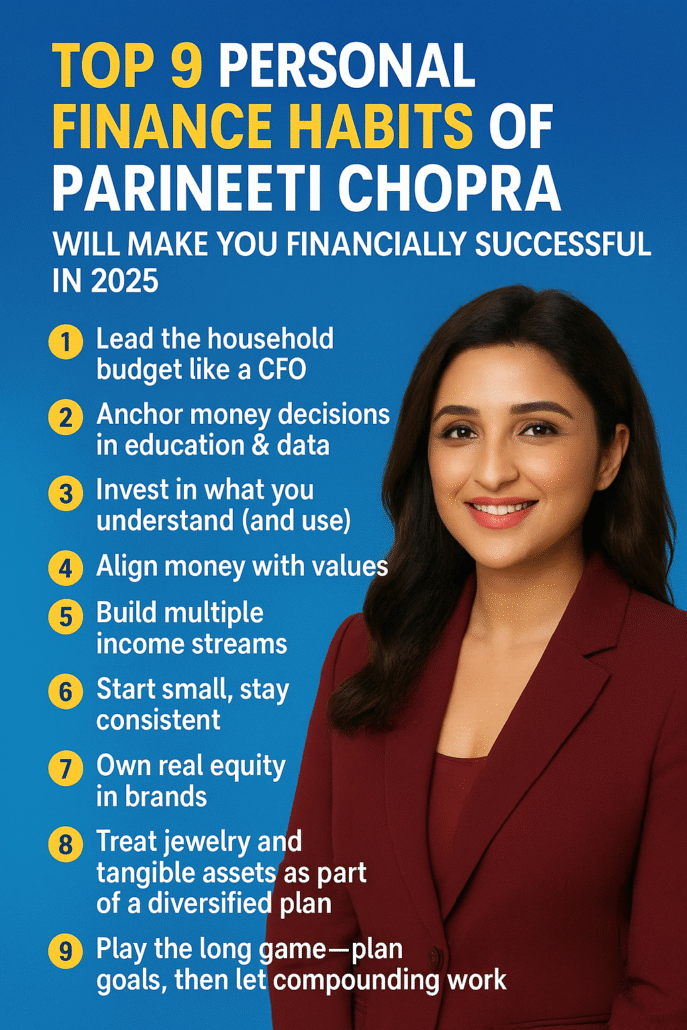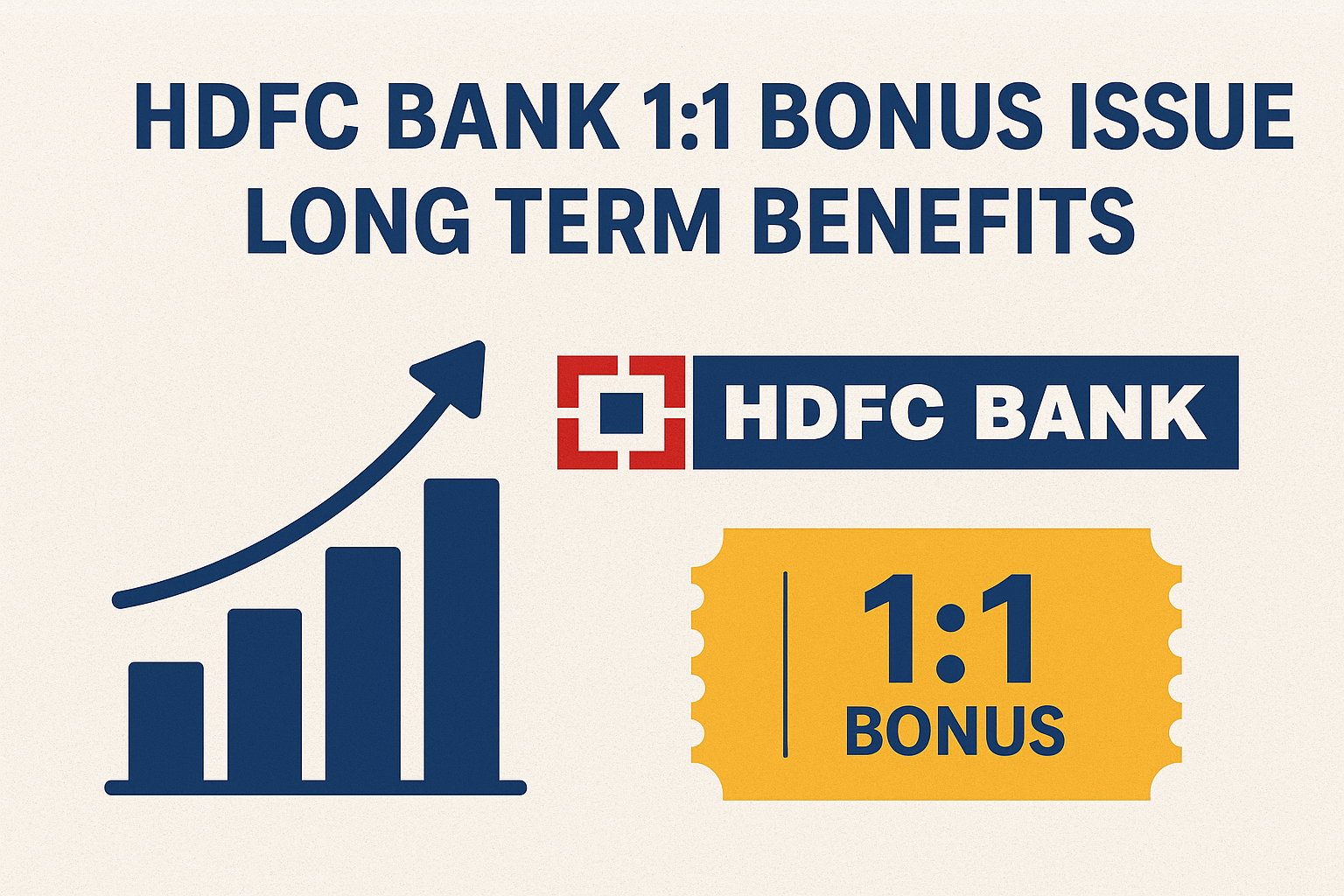Why study the personal finance habits of Parineeti Chopra?
Parineeti Chopra brings a rare blend to money management: formal training in business, finance and economics plus real-world choices—running household finances, value-aligned brand partnerships, and startup investments—that we can actually emulate. She studied at Alliance Manchester Business School with a triple honours in business, finance and economics, once planning to become an investment banker. That background helps explain the structured, numbers-first slant you’ll see in these habits.
She’s also publicly joked (and revealed) that she manages the money at home—her husband Raghav Chadha called her both the “Finance and Home Minister” on a TV appearance—which underlines her hands-on approach to budgeting and cash-flow leadership. here in this blog you will come to know some informations collected from The Times of India
Add to that her angel investments in Clensta (eco-friendly personal care) and Tritiyaa Fine Jewellery, showing a bias toward businesses she understands and values (sustainability, craftsmanship).
Below are the top nine habits you can copy in 2025—each with a “How you can do it” playbook.
Habit 1: Lead the household budget like a CFO
What Parineeti does: Publicly, she’s credited with taking charge of household finances—humorously crowned the Finance Minister at home. Translation: someone’s accountable, decisions are centralized, and spending aligns to goals.
Why it works: Money gets wasted when no one owns it. A single “budget captain” avoids duplication, late fees, impulse splurges, and missed investments.
How you can do it (2025 playbook):
-
Assign a Budget Owner (could be you).
-
Run a Monthly Money Council (30 minutes): look at bank/Credit Card/SIP statements, upcoming annual expenses (insurance, school fees), and set a spend cap for the month.
-
Automate essentials: EMI, rent, utilities, insurance, SIPs.
-
Keep a ** “Fun Fund” envelope** (UPI sub-wallet) so guilt-free treats don’t break targets.
KPI: Savings rate ≥ 20% of take-home; SIPs run on the 1st/5th of each month.
Habit 2: Anchor money decisions in education & data
What Parineeti does: She graduated with triple honours in business, finance, economics and once aimed for investment banking—that’s a data-first lens.
Why it works: Education defeats FOMO. You measure risk, understand compounding, and pick products that match goals (not hype).
How you can do it:
-
Keep a Money Notebook: goal, horizon, product, costs, risk, expected return range.
-
Read one fund factsheet and one insurer brochure per week; log expense ratio/TER, riskometer, 3/5/7-yr rolling returns, and drawdown.
-
Use a Decision Checklist: “Do I understand how this makes money? What could go wrong? What’s the exit plan?”
KPI: 0 impulse financial buys for 90 days; every new investment documented.
Habit 3: Invest in what you understand (and use)
What Parineeti does: She took an equity stake in Clensta, a science-backed, eco-friendly personal care brand, after engaging with the business and its values. She’s also publicly discussed her investment debut and the vision behind it in interviews.
Why it works: Familiar sectors reduce blind spots; due diligence improves.
How you can do it:
-
For equities/mutual funds: stick to sectors you actually use (banking, telecom, FMCG).
-
If considering startup/angel platforms, invest tiny, diversify wide, and insist on unit economics you can explain to a 12-year-old.
KPI: A one-page thesis for every stock/fund/venture you buy.
Habit 4: Align money with values (sustainability & “clean” consumption)
What Parineeti does: Her choices emphasize sustainability/clean beauty—from backing Clensta to serving as brand ambassador for La Pink, a microplastic-free/clean-beauty positioning. Value alignment isn’t just PR; it filters where time and money go.
Why it works: When your values and money point the same way, you naturally avoid wasteful spend and stick to the plan.
How you can do it:
-
Write a Money Manifesto: e.g., “No single-use junk; buy durable; invest in companies improving health/planet.”
-
Add an ESG tilt with guardrails (low fees, transparent methodology).
KPI: 80% of discretionary spend passes your “values” filter.
Habit 5: Build multiple income streams (endorsements, performances, equity)
What Parineeti does: Beyond films, she monetizes via brand endorsements and equity stakes (Clensta, Tritiyaa). Industry trackers and media have long documented her brand tie-ups (FMCG, beauty, apparel, more).
Why it works: Job income is single-point failure. Side incomes cushion volatility and speed up investing.
How you can do it:
-
Pair your day job with two side streams: (1) Skill-based freelance/consulting; (2) Passive/portfolio (SIPs, REITs, bonds).
-
Convert reputation into revenue: workshops, paid newsletters, niche courses.
KPI: Non-salary income ≥ 15% of your total income in 12 months.
Habit 6: Start small, stay consistent—frugality builds resilience
What Parineeti has shared: She’s spoken about growing up with “very less,” including birthdays marked by cutting a single rasgulla instead of a cake—stories echoed across mainstream outlets. The point isn’t drama; it’s a mindset of making do, prioritizing, and appreciating money.
Why it works: Frugality is the engine that powers investments. Without surplus, compounding is a fairy tale.
How you can do it:
-
Run a 30-Day No-Buy on non-essentials.
-
Adopt the Upgrade Rule: You can upgrade only when (a) current item is used to 80% life, and (b) the upgrade pays back in time/health/money.
KPI: Cut lifestyle creep; raise SIP by 10% every appraisal.
Habit 7: Own real equity in brands, not just ad slots
What Parineeti does: She didn’t stop at endorsements. She bought stakes—first Clensta, then Tritiyaa Fine Jewellery—effectively moving from “paid to promote” to “paid + owner upside.” Multiple credible business outlets, deal trackers and brand releases corroborate these stakes.
Why it works: Equity converts your time and reputation into compounding wealth.
How you can do it:
-
Negotiate ESOPs or profit-share in early-stage gigs.
-
Swap a portion of cash fees for equity only if you believe in the product, team, and runway—and only after reading the cap table.
KPI: At least one small equity position by year-end (start with employee ESOPs/RSUs if available).
Habit 8: Treat jewellery and tangible assets as part of a diversified plan
What Parineeti does: Her investment in Tritiyaa coincided with showcasing craftsmanship and wedding-season use-cases. Media coverage around the launch explicitly notes her investor-partner role. While jewellery is consumption, the underlying gold/diamond value plus resale/liquidity gives it a unique place in Indian portfolios—when bought smart.
Why it works (with caveats): Quality jewellery can be a store of value and emergency liquidity. But treat it as tactical, not replacement for diversified market assets.
How you can do it:
-
For investment-grade gold, prefer Sovereign Gold Bonds/ETFs; buy jewellery for use/heritage, check making charges and buy-back.
-
Keep tangible assets ≤ 10–15% of net worth unless you have a specific goal (wedding, heirloom).
KPI: Document purchase price, purity, and buy-back terms for every piece.
Habit 9: Play the long game—plan goals, then let compounding work
What Parineeti has said/done: She called her entrepreneurship a “four-year dream,” then executed with staged entries (first personal care, then jewellery). That’s goal-first, sequenced action.
Why it works: Long-range plans reduce noise. When you know the next right step, you’re less tempted by “hot tips.”
How you can do it:
-
Write 3 flagship goals for 2025–2035 (home down payment, child education, Coast-FIRE).
-
Map each goal to a product bucket:
-
Review once per quarter; otherwise, hands off.
KPI: Annual goal-tracking sheet with XIRR for each bucket.
Quick proof-points & sources you can cite
-
Finance education & career intent: Alliance Manchester Business School; triple honours in business, finance, economics; earlier interest in investment banking.
-
Budget leadership at home: Raghav Chadha on The Great Indian Kapil Show—Parineeti is the “Finance & Home Minister” at home.
-
Equity stakes / entrepreneurship: Clensta minority stake; interviews about her investment debut; Tritiyaa Fine Jewellery investment confirmed by multiple business outlets and trackers.
-
Values-aligned/clean beauty positioning: Clensta’s eco-friendly thesis; La Pink brand ambassadorship and clean/microplastic-free messaging.
-
Frugality origin story: Mainstream coverage of childhood birthdays marked by a single rasgulla instead of a cake.
-
Endorsements/multi-income: Industry roundups and media profiles documenting her brand tie-ups across categories.
Actionable 12-Week “Parineeti-Style” Money Sprint for 2025
Week 1–2: Set one Budget Owner; automate all essentials; list debts with interest rates.
Week 3–4: Open/verify SIPs toward 3 flagship goals; start with index funds + a flexi/large-mid fund; write a 1-page thesis per fund.
Week 5–6: Run a No-Buy on non-essentials; redirect savings to raise SIPs by 10%.
Week 7–8: Start a side income (freelance, weekend workshop); aim for your first ₹10,000 outside salary.
Week 9–10: Draft a Values Filter for purchases/investments; audit subscriptions; cancel ≥ 3.
Week 11: Learn about SGB/Gold ETF; buy a token amount if it fits your plan; log purity/buy-back for any jewellery you own.
Week 12: Review XIRR, cash-flow, side-income progress; set Q2 targets.
FAQs: Personal finance habits of Parineeti (Pariniti) Chopra—answered for 2025
Q1. Does Parineeti Chopra actually manage money at home?
Yes—on a recent TV appearance her husband Raghav Chadha joked that she’s both the Finance and Home Minister, implying she leads budgeting and spending decisions.
Q2. Is her finance education real or a PR line?
It’s real. She studied at Alliance Manchester Business School, completing a triple honours in business, finance and economics, and earlier wanted to be an investment banker.
Q3. What companies has she invested in?
At least two publicized stakes: Clensta (eco-friendly personal care) and Tritiyaa Fine Jewellery (boutique jewellery brand).
Q4. Is this about copying a celebrity or learning systems?
It’s about systems—budget leadership, education-first decisions, values alignment, multiple income streams, equity ownership, and long-term planning—all of which you can implement without celebrity money.
Q5. What if I’m starting from zero in 2025?
Start with expense tracking + 20% savings rate + emergency fund of 6 months + auto-SIPs. Add side income within 60 days. Scale steadily.
Final word
If you copy only three personal finance habits of Parineeti Chopra (Pariniti Chopra) in 2025, make them these: own the household budget, invest in what you understand (preferably with real equity where possible), and let values guide your money. Layer on education and long-term planning, and you’ll have a playbook strong enough to weather dips, fund dreams, and compound quietly in the background.
![]()



